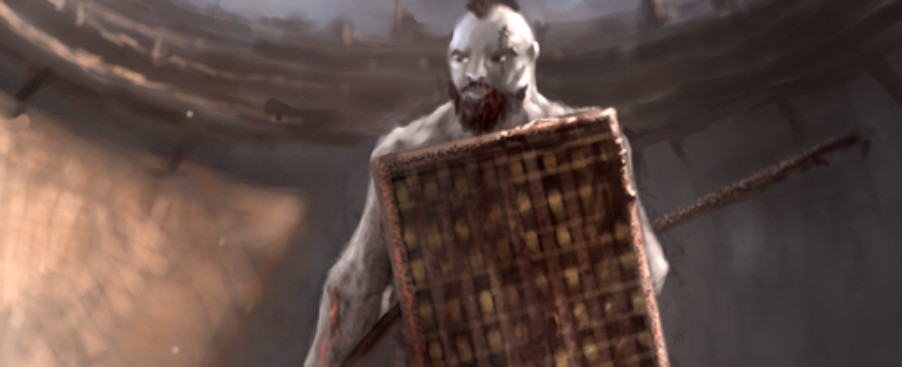Knights of the Chalice 2 Updates, $41,184 and Counting
-
Category: News ArchiveHits: 1381

According to the latest Kickstarter update, Heroic Fantasy Games’ crowdfunding campaign for Knights of the Chalice II has reached its third stretch goal, ensuring that the upcoming RPG will feature spell shortcuts and customizable quick bars.
And if you’d like to learn more about this game’s systems and features, you may want to check out the other recent updates. Update #17 showcases some adventure maps. Update #18 talks about the game’s editor. Update #19 introduces us to three of the game’s companions. And update #20 shares some tips on how to fight enemy spellcasters.
Here’s more on the latter:
How to Fight Enemy Spellcasters in KotC 2
Hello everyone! In this update, we will provide some advice on the tactics that your Heroic Party can use to fight enemy spellcasters in KotC 2. Spellcasters can be broadly categorised according to their level:
1) Low-level casters are the typical ‘glass canons’. They have the ability to hurt your party by firing a single spell like Sleep, Glitterdust, Stinking Cloud or Fireball. However, they are physically weak and can be defeated easily.
2) Mid-level casters are more resilient as they are often protected by Mirror Image and Stoneskin Personal. They are dangerous opponents. Therefore, it’s a good idea to concentrate your party’s initial attacks on them. Watch out for spells such as Solid Fog, Frailty, Cone of Cold and Chain Lightning.
3) High-level casters are among the most difficult opponents faced by the party. They usually benefit from a range of permanent protective spells and protective magic items.
The most dangerous casters are those who can start combat by casting Accelerated Spell on themselves, immediately followed by Prismatic Void, Weird or Meteor Shower during the first round.
These spells are very disruptive to the party, especially if the enemy can cast them two times in quick succession. Therefore, your party has a much better chance of survival if it gets to act first and if it makes intelligent use of the Ready Versus Spell special initiative action.
Give your own casters the feat Improved Initiative and increase their Dexterity and Initiative bonus with magic items such as the Ring of Initiative, Belt of the Fighter, Boots of Initiative and Bracers of Dexterity.
Let your spellcasters cast Accelerated Spell in the first round, followed by an offensive spell, followed by a Ready Versus Spell action targeted at one of the enemy casters who have not yet had their turn during the current round.
When your Ready Versus Spell action is triggered by the enemy caster, consider using a damaging spell or psionic power that bypasses Spell Resistance, such as Vortex of Doom, Hail of Crystals, Whirlwind or Earthquake. Prismatic Void, Weird and Meteor Shower can also be very effective.
If one of your casters, such as a Bishop, cannot cast Accelerated Spell, while another of your casters, such as a Wizard, can cast it, then consider having the second character cast Accelerated Spell on the first character, so that both of your casters will be able to cast two spells per round.
A number of additional spells and weapon enchantments deserve a special mention here:
- Stinking Cloud: This medium-range spell has no Spell Resistance check and it triggers a Fortitude Saving Throw. Therefore, casters are very vulnerable to this spell.
- Quicksand: This long-range level-two Druid spell has no Spell Resistance check and it triggers a Reflex Saving Throw. Therefore, casters are very vulnerable to this spell.
- Antimagic Cloud: Casting this long-range spell on enemy spellcasters can be a very effective tactic.
- Silence and Zone of Silence: These simple long-range spells can also be very effective. However, psionic-power manifesters are unaffected and some enemies may have the feat Metamagic Silent.
- Acid Arrow: This long-range level-two Wizard spell has no Spell Resistance check and affected targets may have to succeed on concentration checks to cast.
- Turn Pebble to Boulder: This long-range Druid spell has no Spell Resistance check.
- The spells Dispel Magic and Greater Dispel Magic can be used to remove the beneficial magic effects of enemy casters, such as Accelerated Spell and Mirror Image.
- The Time Cleric Domain, the spells Slow and Time Control and the Slowing weapon enchantment may be useful, as a Slowed caster with Accelerated Spell can no longer cast two spells per round.
- Both the spell Lower Spell and Power Resistance and the weapon enchantment Shattermantle can be used to reduce a target’s Spell Resistance.
- Dispelling weapons may also be useful in removing the enemy’s protective magic.

